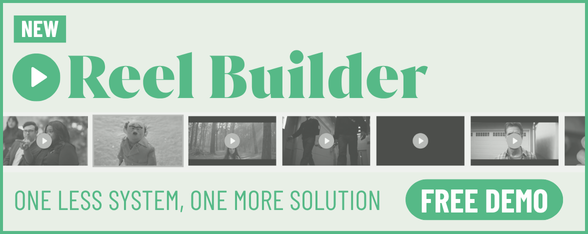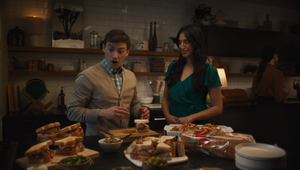
How Makers Achieved a 100% Carbon Neutral Production

What defines ‘successful’ and ‘great’ advertising? Is it the amount of attention generated? Is it found through receiving positive public feedback? Or is it the number of awards won in the festival circuit? While all three of these things are undoubtedly representative of ‘great’ advertising, for Canadian beauty company DECIEM, the pursuit of ‘success’ came in a unique way. Rather than chasing any one of these specific things, they sought their success in the sustainability sphere - challenging the industry to match their dedication to the future of the planet.
Partnering with global production network Makers, the two worked together to produce a campaign video that not only served as an effective marketing tool, but was achieved with 100% carbon neutral production. By deviating from traditional production standards - such as using LED wall technology instead of travelling to various shooting locations and investing in wind power energy from wind farms certified by the UN Carbon Offset Platform - the making of this campaign proved that the future of advertising can be achieved in an environmentally-friendly fashion, as long as brands and production companies have the will and care to do so.
LBB’s Josh Neufeldt sat down with Makers executive producer Tasha Jameson to find out how this benchmark was achieved.
LBB> The video was made with 100% carbon neutral production. Why did you decide to do this?
Tasha> There’s a lot of talk about sustainable production in our industry, but not a lot of meaningful action. This year, Makers launched an internal sustainability team that’s focused on tangible action and developing new standards to dramatically reduce the carbon footprint in the production process. We wanted to push beyond the current practices of no plastic water bottles on set, and composting and recycling - which are all well-meaning initiatives but don’t address the biggest areas of waste and pollution. When DECIEM approached us to produce their sustainability story, it was an ideal project for us to pitch the application of our new practices, as we knew the DECIEM team, like us, possess a doer culture - committed to putting action behind their words. DECIEM is a brand that’s all about challenging the beauty landscape and how it approaches sustainability. They’re embedding sustainability throughout their entire business model, so we wanted to help them carry that all the way through their brand messaging as well.
LBB> Is it something you have done before? Did you have any expectations for how the shoot would go? And how did the actual experience compare to what you anticipated?
Tasha> We’ve executed projects with reduced carbon emissions, but this was our first time achieving 100% carbon neutrality. We were optimistic about a carbon neutral outcome based on our previous learnings, but each project is unique and requires a great deal of strategic thought, collaboration, and a willingness to think and work outside the status quo. Thankfully, on this one, our team was able to come up with a clever solution that satisfied creative, budgetary and timeline requirements harmoniously.
LBB> Tell us more about the process! How did this goal affect the way you shot?
Tasha> We chose to focus on the areas of greatest carbon output, which are often travel/transportation and energy. These are requisites for completing a carbon neutral production.
The creative involved multiple locations. Instead of travelling to four different shoot locations, we used LED volume wall technology - courtesy of our friends over at Immersion Room - to replicate those locations remotely. We essentially brought the locations to us and centralised the whole process. This technology can be expensive, so we really had to dig around for a smaller LED wall set up that fit our creative ask. We worked in lockstep with the Immersion Room team to find efficiencies on timeline and budget wherever possible, including cost effective stock footage that we could manipulate to our needs.
By virtue of using that single studio space and LED wall technology in place of traditional lighting, the energy and transportation impact was cut significantly - right off the bat. From there, we worked with each department to ensure as much reduction in waste as possible by offering advice, green alternatives, and working through each step of production through the lens of sustainability, until we were left with a minimal carbon footprint – approximately 18 times less than what a typical one-day shoot emits. That remaining footprint was then offset by using wind power energy from wind farms certified by the UN Carbon Offset Platform.

LBB> How did shooting with the goal of a 100% carbon neutral production impact the cost, length and amount of effort required? And is this something that you’ll easily be able to do again in the future?
Tasha> Although each project’s quest to reach carbon neutrality is unique, we’re super happy to have reached our goal without any impact on budget or timeline. As we integrate these new systems, of course our effort levels are going to be higher while we work to educate our clients and vendor partners - but it’s a true labour of love.
For this DECIEM project, it took less additional planning than what was required for proper covid-19 protocols on set, so we know it’s within everyone’s capabilities to replicate this success!
As we continue our sustainability journey, we’re excited to explore additional techniques and technologies that afford us an opportunity to limit our carbon footprint even more.
LBB> What are the biggest takeaways you’ve had from this experience? If you were on set, do you have any interesting anecdotes or lessons learned?
Tasha> Achieving a carbon neutral production isn’t that difficult if you have the passion and quorum from all partners to achieve it, and make time for thoughtful planning discussions early on. In its simplest terms, it’s thinking through each phase of production through the lens of the now famous ‘70s adage: ‘reduce, reuse, recycle’. Posing questions like, ‘Do we really need this?’, ‘If so, does it need to be a new one?’ and ‘What is the lifecycle of this item after we’re done with it, and how can we ensure this isn’t its final stop before the dump?’ are all very important.
Another easy first step is ensuring things like proper composting and recycling, and promoting rideshares when coming to set. If you want to take it further and make a meaningful change, you’ve got to rethink your travel/transportation and energy consumption. (Examples: Do you really need to fly out for the shoot? Can you find multi-purpose locations? Can you utilise natural light sources or ones that are more efficient?)
Carbon neutrality can be achieved in many ways. We often hear about projects that buy carbon offsetting credits and that’s the end of their story. But we’re not just buying credits; we’re retooling the production process at every step - and only after every attempt is made to reduce, reuse, and recycle do we offset whatever carbon footprint is leftover using UN-sanctioned programs. It’s important to understand that on their own, offsetting programs are not enough. There must be other systemic change throughout the production process before you invest in offsetting
programs that add power back to the grid.

LBB> What challenges have you faced during this project? How did you overcome them?
Tasha> We had never achieved an entirely carbon neutral production before, and we were working with a short timeline and limited resources. When you don’t have an endless supply of money or time to throw at challenges, you must get crafty. We knew, no matter the outcome, we would push as hard as possible to get to achieve this end goal. The DECIEM team was wholeheartedly supportive of this effort and gave us the opportunity and space to find ways to reach our collective goal.
Even to our own surprise, we successfully achieved the creative vision without needing to compromise any scenes or adjust the final deliverable. As a team, we had many collaborative conversations about types of location backgrounds, angles, lighting approach, budget, and more, but always tracked along our north star of nailing the creative within sustainable means.
During this process, we came across some happy accidents as well. Our in-camera wind gags were way easier to control in the studio than they would have been on location. We love when that happens!
LBB> Sustainable production is a huge topic right now. What can other brands and companies be doing to shoot in more environmentally friendly ways? Does the industry need to be proactively doing more, in your opinion?
Tasha> Absolutely. The industry should do more, and can do more. All it takes is a suggestion. Not every client will bite, but a lot of them will. If you can’t secure a nibble based off of environmental concerns alone, you can also lean into its marketability to gen z, who care deeply about the planet’s wellbeing and drive over $140 billion worth of buying power.
The demand for greater sustainability in business models is not going away. Large global companies like Apple and Microsoft have announced their plans to be carbon neutral or negative by 2030. These are not some far-off dreams. There is a real demand for it from the public. Brands cannot afford to overlook sustainability.
My advice is to focus your attention on where you can make the biggest impact. It’s not just removing water bottles and having composting on set. That makes a small dent, but transportation and energy are the biggest factors. It’s not always the easiest path, but the end result is incredibly rewarding and, in our case, showed the client what a valuable strategic partner we are.
LBB> Is there anything you’d like to add?
Tasha> There’s no reason to be intimidated. Bite off what you can chew, and push yourself to tackle a bit more with every project. If you’re struggling on where to begin or how to start the conversation with clients or vendor partners, there are many sustainability consultants, including us right here at Makers.















